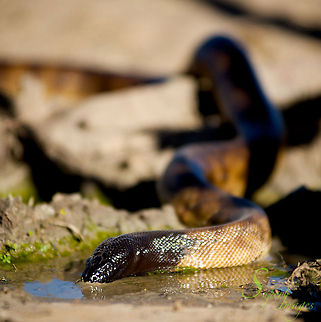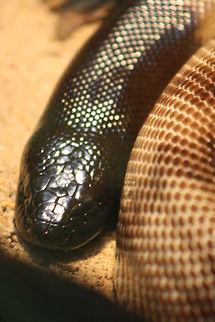
Appearance
Adults grow to an average of 1.5 to 2 m in total length, but can grow to a maximum total length of 3.5 m , although average specimens are about 2 m in total length. The body is muscular with a flattened profile, while the tail tapers to a thin point.The top of the head is covered by large symmetrical scales. The dorsal scales, which are smooth and glossy, number 50-65 rows at midbody, while there are 315-355 ventral scales. The tail has 60-75 mainly single subcaudal scales and the anal scale is single. The posterior subcaudals tend to be divided, often irregularly.
The color pattern consists of shades of black, dark grey, brown, gold, and cream arranged in a striped or brindled pattern. The belly is light-coloured, flecked with darker spots. The head is shiny black that also extends down the neck and throat for several inches.

Behavior
These snakes are terrestrial and are often found in amongst rocks and loose debris. If disturbed, they will hiss loudly, but are unlikely to bite unless hunting prey. They will sometimes strike with a closed mouth, but generally can be handled easily. They are strong swimmers, but are almost never found inside water. They are non-venomous.Habitat
Occurs in humid tropical to semi-arid conditions.Reproduction
Oviparous, with 5-10 eggs per clutch. The females stay coiled about the eggs and incubate them until they hatch, which is usually after 2-3 months. The young will take small prey as soon as two days after hatching. Immature individuals are vulnerable to predation, including cannibalism. Adults have no natural predators other than dingos and humans.Food
The diet consists of mainly reptiles, but they will eat mammals if available. Because black-headed pythons live in the desert, they heat up a lot quicker and stay warmer for longer. This means they can eat more because they digest food quicker in warmer conditions. When ingesting large prey this species positions one or two coils just ahead of its distended mouth and by constriction makes the task of swallowing easier.Cultural
These snakes are mentioned in, or play a central role in, the stories of the Indigenous Australians Dreamtime tradition.References:
Some text fragments are auto parsed from Wikipedia.